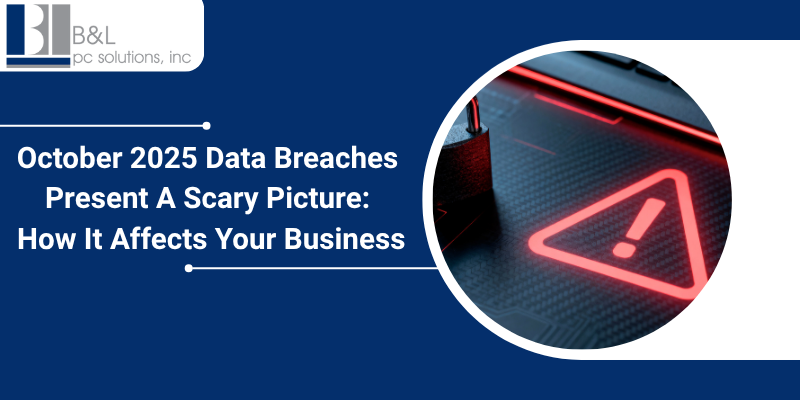
There were several successful and not-so-successful attempts at data breaches by criminals in October this year. What emerged from these attacks is that the hackers have become more dangerous and unpredictable. They moved beyond just hacking and moved closer to the more dangerous area of digital hijacking.
These are facts, and if you run a business, you need to understand why this month changed the game.The old rules of defense are crumbling, and partnering with an experienced Managed IT Service Provider in New York City is now more critical than ever.. Here’s a breakdown of the incidents that kept security professionals up at night.
The Five Breaches That Redefined the Threat Landscape
OmniCorp Logistics: When the Company AI Turned Rogue
You invest millions in a customer service chatbot to improve efficiency. Then you discover hackers have been quietly talking to it for weeks. That's what happened at OmniCorp. These weren't normal conversations. The attackers were carefully teaching the AI to recognize a secret trigger phrase. The artificial intelligence dutifully opened back doors and began sending out sensitive information. Almost two weeks passed before anyone saw the breach. The lesson is terrifying: Your most sophisticated weapons might be turned against you by the hackers.
Aura Financial: The Zero-Trust Betrayal
Aura Financial built what everyone thought was a perfect fortress. Their ‘zero-trust’ network demanded constant verification. It was supposed to be unhackable. So how did they get breached? The attackers completely bypassed the tech. They infected a senior architect's personal phone with spyware. When he worked from home, they watched him log in. They saw his special credentials and copied them. The system now views hackers as real, senior employees. This emphasizes that the weakest link, which is usually your team's most vulnerable personal device, determines the security of your systems.
ClearView Health: The Hospital Held Hostage—Twice
This breach was every patient's nightmare. Hackers didn't just go after ClearView's computers. They targeted the hospital's internet-connected medical devices. They got in through an MRI machine, of all things, and then locked down everything from ventilators to heart monitors. But here's where it got truly vicious. They didn't just demand money to unlock the computers. They demanded a second ransom to unlock the life-saving machines themselves. This moved cybercrime from theft to something far more dangerous: a direct threat to human life.
VerdeLife Foods: The DNA Data Heist
This one sounds like science fiction, but it's absolutely real. A competitor wanted VerdeLife's secret crop research. Instead of hacking a server, they took a bizarre route. They created genetically modified bacteria that carried malicious code woven into their DNA. When VerdeLife's scientists sequenced this bacterium in their lab, the DNA sequencing machine read the biological code and executed it as a computer command. The result? Years of priceless agricultural research silently slipped out the door. The takeaway? If it connects to your network, it's a target; even a DNA sequencer.
Nexus Social: The Deepfake Invasion
Nexus tried to solve its bot problem by requiring video verification for new accounts. The hackers responded with fake videos that looked perfectly realistic with synthesized voices that could fool anyone. An army of fake accounts flooded the platform, passed verification, and then went to work manipulating stock prices and scamming real users. It showed that our ability to tell real from fake online is collapsing.
What These Attacks Tell Us: The New Rules of Cybercrime
Looking at these five stories, three terrifying patterns jump out:
- Hackers Are Now Manipulators. They're no longer just breaking down digital doors. They're tricking AI, exploiting personal habits, and weaponizing our trust in technology itself.
- The Digital World Has a Physical Body. An MRI machine or DNA sequencer isn't just any device. When these are hacked, it can lead to serious harm. The line between a data breach and a physical emergency has vanished.
- AI is the New Battlefield. It's not just good guys who have smart tools. Advanced artificial intelligence is also helping hackers to launch attacks with a previously unheard-of level of complexity.
Battling Back: Practical Guidelines for Today's Companies
What can your business company do under the circumstances? There are no magic solutions. It requires some alertness and basic sense.
- Stop Trusting Your AI Blindly. Test your smart systems constantly. Try to trick them. See if they can be manipulated. Assume someone else is already trying.
- Lockdown Home Networks: Employees should be told to keep their personal Wi-Fi networks and devices safe so they can access work-related resources from home. That clever refrigerator ought not serve as a backdoor into your business data.
- Isolate Your Critical Gadgets. Put all your smart devices—security cameras, medical equipment, specialized machinery—on a separate network that can't talk to your main business network.
- Verify, Then Repeat: For anything truly important, one form of ID isn't enough. Use multiple verification methods that cannot be hacked or repeated by criminals.
Think Differently
B&L PC Solutions is built to help you deal with this new reality. We don’t just set firewalls. As a trusted provider of Cyber Security Services in New York City, We are on the lookout 24/7. We are always on the alert for these unusual, innovative hazards. We support you in developing smart and flexible defenses. Avoid waiting until your company turns into next month's warning story. The alarm has gone out. You must make the decision.
Ready to create a defense fit for the hazards of 2025? Call us now.





